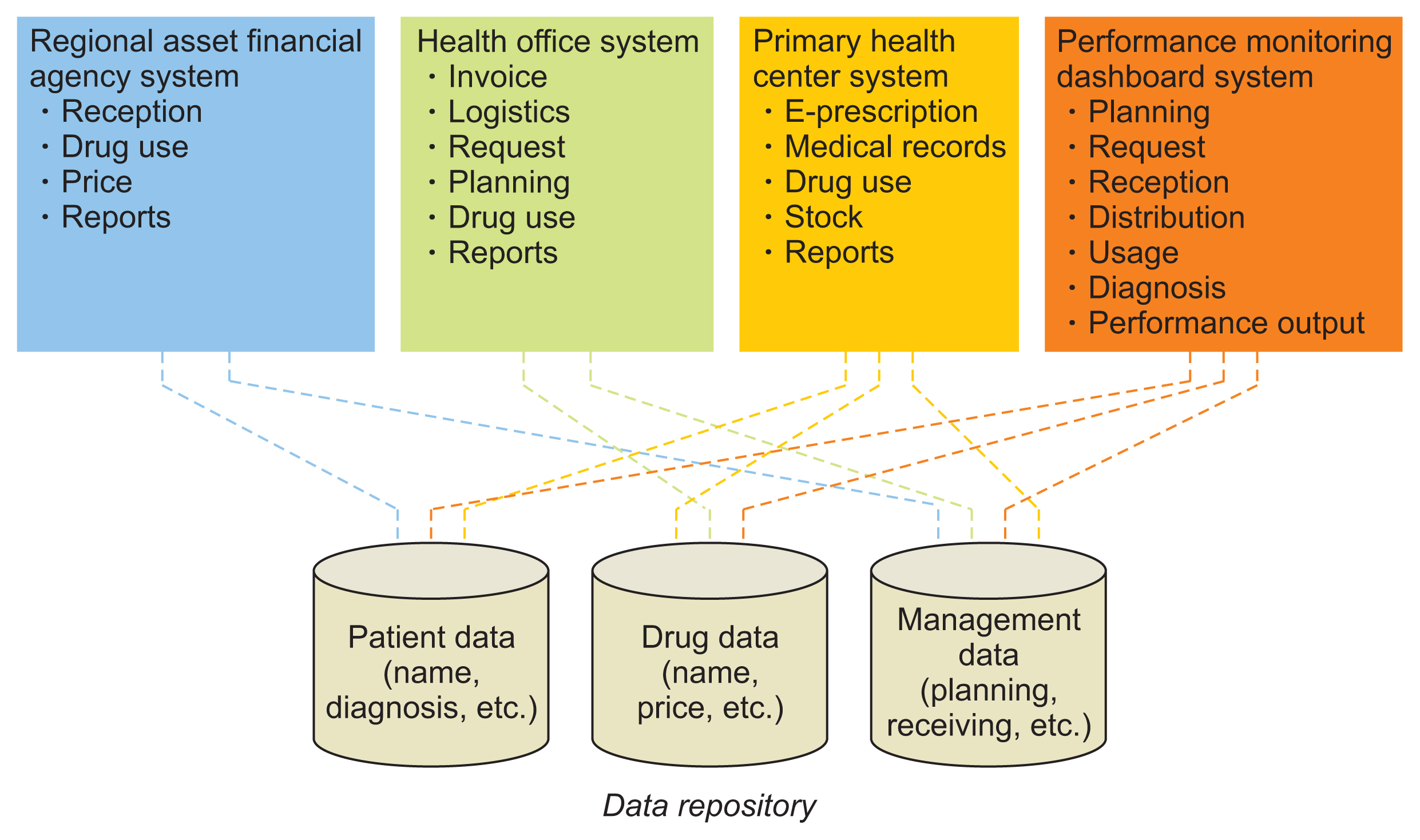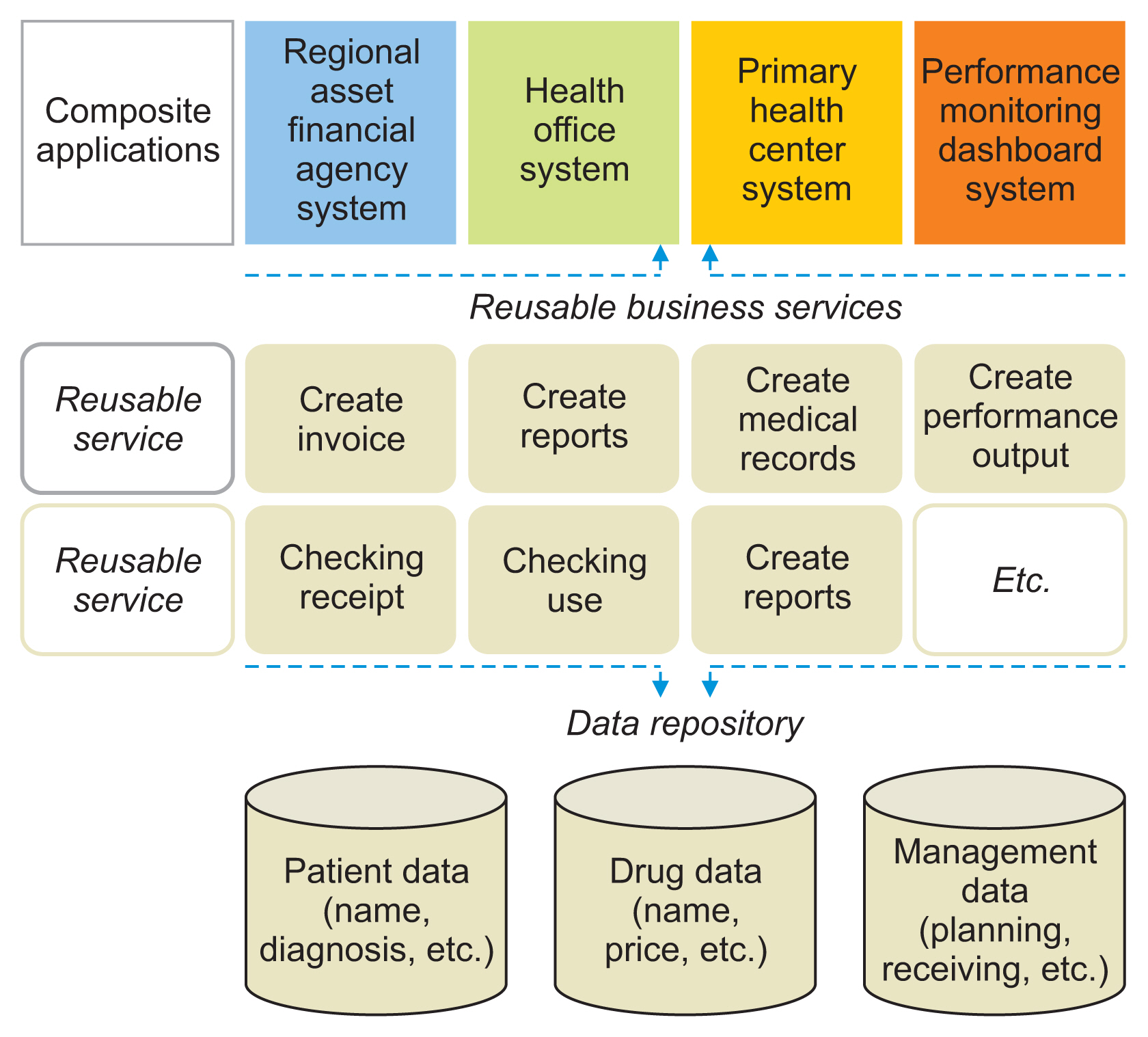Healthc Inform Res.
2023 Apr;29(2):103-111. 10.4258/hir.2023.29.2.103.
Development of a Drug Management Performance Application: A Needs Assessment in Indonesia
- Affiliations
-
- 1Faculty of Pharmacy, Universitas Gadjah Mada, Yogyakarta, Indonesia
- 2Faculty of Pharmacy, University of Pancasila, Jakarta, Indonesia
- 3Department of Pharmaceutics, Faculty of Pharmacy, Universitas Gadjah Mada, Yogyakarta, Indonesia
- 4Department of Health Policy and Management, Faculty of Medicine, Public Health, and Nursing, Universitas Gadjah Mada, Yogyakarta, Indonesia
- KMID: 2542136
- DOI: http://doi.org/10.4258/hir.2023.29.2.103
Abstract
Objectives
This study assessed the current state of pharmacy management information systems in Indonesia and systematically determined the improvements needed from the stakeholders’ perspective.
Methods
This descriptive study used focus group discussions and observations in 13 institutions, and 17 respondents were selected by purposive sampling. The PIECES (performance, information, economy, control, efficiency, service) framework was used to help identify needs. The research was conducted from September 2021 to November 2021 at primary health centers and health offices in Yogyakarta, Indonesia and involved pharmacists and information systems staff. esults: There was no standardized information system in place to support drug management and no format or rules for drug labeling (performance). Pharmacists were not able to provide non-prescription services outside the pharmacy warehouse (information). A new system needs to be developed, and budget availability needs to be determined (economy). System security decreases when users share accounts (control), and the existing systems have not been integrated as needed (efficiency). It is first necessary to plan and support regulations for system development (service). The authors formulated a recommended drug labeling format and a proposed system integration plan.
Conclusions
The development of an information system to support drug management is eagerly awaited by pharmacists in Indonesia to assist in their work. Further research on the development and implementation of an information system is needed to improve the quality of drug management at primary health centers.
Figure
Reference
-
References
1. Bruno O, Onchweri AN, Ondieki MC, Nyabayo MJ. Availability of essential medicines and supplies during the dual pull-push system of drugs acquisition in Kaliro District, Uganda. J Pharma Care Health Syst. 2015. [Epub]. https://www.longdom.org/open-access/availability-of-essential-medicines-and-supplies-during-the-dual-pullpush-system-of-drugs-acquisition-in-kalirodistrict-34382.html.2. Indriawan I, Wahyudi WT, Rahayuningsih A. Analysis of drug management at Gaya Baru Health Center V, Bandar Surabaya District, Central Lampung Regency. J Holist Health. 2014; 8(1):1–6.3. Latifah E, Kristina SA, Suryawati S. Overview of drug availability and influencing factors in several low, lower and upper-middle countries: a systematic review. Syst Rev Pharm. 2019; 10(1):67–72.
Article4. Chaira S, Zaini E, Augia T. Drugs management evaluation at community health centers in Pariaman City, Indonesia. J Sains Farm Klin. 2016; 3(1):35–41. https://doi.org/10.29208/jsfk.2016.3.1.97.
Article5. Carolien I, Fudholi A, Endarti D. Evaluation medicine availability before and after NHI implementation at health centers in Keerom District, Papua Province. J Manag Pharma Pract. 2017; 7(1):30–39. https://doi.org/10.22146/jmpf.30294.
Article6. Satibi S, Rokhman MR, Aditama H. Developing consensus indicators to assess pharmacy service quality at primary health centres in Yogyakarta, Indonesia. Malays J Med Sci. 2019; 26(4):110–21. https://doi.org/10.21315/mjms2019.26.4.13.
Article7. Hidayat MK. Design and build a drug supply information system at the Babelan I Health Center, Bekasi Regency. JIMP. 2019; 4(1):8–17. http://doi.org/10.37438/jimp.v4i1.193.
Article8. Wardani RR, Devitra J. Analysis and design of drug supply information systems at Payo Selincah Health Center Jambi. J Inf Syst Manag. 2017; 2(2):455–69.9. Wibisono S, Munawaroh S. Management information system for community health centers (Simpuskesmas) based on cloud computing. J Teknol Inf Dinamik. 2012; 17(2):141–6.10. Jaelani AK, Andayani TM. Development of management information system models for outpatient patient screening at community health centers in the city of Yogyakarta. J Manag Pharm Pract. 2015; 5(4):301–12.11. Nilansari AF, Putri PH. Requirements analysis and design of information systems model for outpatient prescription screening in Kotagede I Health Center. Indones J Pharm Nat Prod. 2020; 3(2):1–10. https://doi.org/10.35473/ijpnp.v3i2.543.
Article12. Tabrani M. Implementation of the waterfall method in the design of information systems on outstanding services Telagasari Community Health Center Karawang. Indones J Bus Intell. 2019; 2(2):79–89. http://dx.doi.org/10.21927/ijubi.v2i2.1125.13. Whitten JL, Bentley LD. Systems analysis & design methods. Boston (MA): McGraw-Hill;2007.14. Pratama IP. IT system Integration and Migration. Bali, Indonesia: Universitas Udayana;2016.15. Alanazi A, Al Rabiah F, Gadi H, Househ M, Al Dosari B. Factors influencing pharmacists’ intentions to use pharmacy information systems. Inform Med Unlocked. 2018; 11:1–8. https://doi.org/10.1016/j.imu.2018.02.004.
Article16. Nesi G, Kristin E. Evaluation of medicine planning and procurement in pharmaceutical installations Kefamenanu Hospital, Timor Tengah Utara Regency. Indones J Health Policy. 2018; 7(4):147–53.17. Karimah C, Arso SP, Kusumastuti W. Analysis of drug management at the procurement stage at Roemani Muhammadiyah Hospital Semarang. J Public Health. 2020; 8(2):182–7.18. Matunga DA, Nyanamba SO, Okibo W. The effect of e-procurement practices on effective procurement in public hospitals: a case of Kisii level 5 hospital. Am Int J Contemp Res. 2013; 3(8):103–11.19. Quist AJ, Hickman TT, Amato MG, Volk LA, Salazar A, Robertson A, et al. Analysis of variations in the display of drug names in computerized prescriber-order-entry systems. Am J Health Syst Pharm. 2017; 74(7):499–509. https://doi.org/10.2146/ajhp151051.
Article20. Miller AS. Pharmacy issues: drug nomenclature. Hospital Pharmacy. 2000; 35(11):1249–51. https://doi.org/10.1177/001857870003501116.
Article21. Sumiarni L, Gustina R. Evaluation of drug management at the Rantau Panjang Health Center, Merangin Regency in 2015. J Health Appl Sci. 2018; (1):12–28.
- Full Text Links
- Actions
-
Cited
- CITED
-
- Close
- Share
- Similar articles
-
- Medical students in Indonesia: an invaluable living gemstone during coronavirus disease 2019 pandemic
- Health Referral Enterprise Architecture Design in Indonesia
- The management of food allergy in Indonesia
- Radiology Loading and Coverage Hours in Indonesia
- Development of the SIKRIBO Mobile Health Application for Active Tuberculosis Case Detection in Semarang, Indonesia




